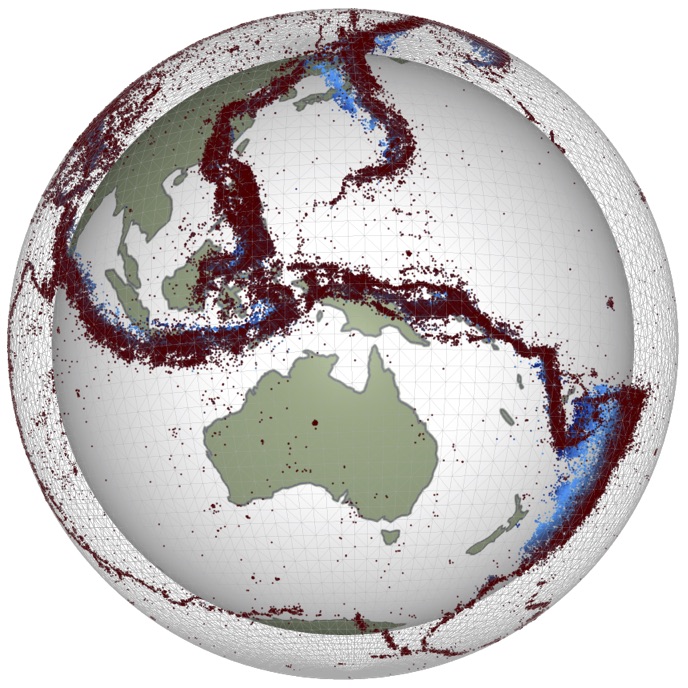Poisson Equation with flux recovery#
Generic scalar solver class#
# to fix trame issue
import nest_asyncio
nest_asyncio.apply()
from petsc4py import PETSc
import underworld3 as uw
import numpy as np
import sympy
# %%
mesh = uw.meshing.UnstructuredSimplexBox(
minCoords=(0.0, 0.0), maxCoords=(1.0, 1.0), cellSize=1.0 / 3.0, qdegree=2
)
mesh.dm.view()
mesh variables
t_soln = uw.discretisation.MeshVariable("T", mesh, 1, degree=3)
dTdY = uw.discretisation.MeshVariable(
r"\partial T/ \partial \mathbf{y}", mesh, 1, degree=2
)
kappa = uw.discretisation.MeshVariable(r"\kappa", mesh, 1, degree=2)
gradT = uw.discretisation.MeshVariable(
r"\nabla\left[T\right]", mesh, mesh.dim, degree=2
)
Create Poisson object
gradient = uw.systems.Projection(mesh, dTdY)
delT = mesh.vector.gradient(t_soln.sym)
gradient.uw_function = delT.dot(delT)
gradient.smoothing = 1.0e-3
These are both SNES Scalar objects
gradT_projector = uw.systems.Vector_Projection(mesh, gradT)
gradT_projector.uw_function = mesh.vector.gradient(t_soln.sym)
# gradT_projector.add_dirichlet_bc((0), ["Left", "Right"], components=(0))
the actual solver#
poisson = uw.systems.Poisson(mesh, u_Field=t_soln)
# %%
poisson.constitutive_model = uw.constitutive_models.DiffusionModel
Non-linear diffusivity
delT = mesh.vector.gradient(t_soln.sym)
k = 5 + (delT.dot(delT)) / 2
poisson.constitutive_model.Parameters.diffusivity = k
display(poisson.constitutive_model.c)
projector for diffusivity (though we can just switch the rhs for the gradient object
diffusivity = uw.systems.Projection(mesh, kappa)
diffusivity.uw_function = sympy.Matrix(
[poisson.constitutive_model.Parameters.diffusivity]
)
diffusivity.add_dirichlet_bc(k, "Bottom", components=0)
diffusivity.add_dirichlet_bc(k, "Top", components=0)
diffusivity.add_dirichlet_bc(k, "Right", components=0)
diffusivity.add_dirichlet_bc(k, "Left", components=0)
diffusivity.smoothing = 1.0e-6
# %%
poisson.constitutive_model = uw.constitutive_models.DiffusionModel
poisson.constitutive_model.Parameters.diffusivity = k
poisson.constitutive_model.Parameters.diffusivity
# %%
display(gradT_projector.uw_function)
display(diffusivity.uw_function)
# %%
diffusivity.uw_function
Set some things
x, y = mesh.X
abs_r2 = x**2 + y**2
poisson.f = -16 * abs_r2
poisson.add_dirichlet_bc(abs_r2, "Bottom", components=0)
poisson.add_dirichlet_bc(abs_r2, "Top", components=0)
poisson.add_dirichlet_bc(abs_r2, "Right", components=0)
poisson.add_dirichlet_bc(abs_r2, "Left", components=0)
# %%
# Linear model - starting guess
poisson.constitutive_model.Parameters.diffusivity = 1
poisson.solve(zero_init_guess=True)
# %%
# Solve time
poisson.constitutive_model.Parameters.diffusivity = k
poisson.solve(zero_init_guess=False)
# %%
poisson.constitutive_model
# %%
gradT_projector.solve()
# %%
gradient.uw_function = sympy.diff(t_soln.sym, mesh.N.y)
gradient.solve()
# %%
gradient.uw_function
# %%
diffusivity.solve()
non-linear smoothing term (probably not needed especially at the boundary)
gradient.uw_function = sympy.diff(t_soln.fn, mesh.N.y)
gradient.solve(_force_setup=True)
# %%
gradT_projector.solve()
Check Construct simple linear function which is solution for above config. Exclude boundaries from mesh data.
import numpy as np
with mesh.access():
mesh_numerical_soln = uw.function.evaluate(t_soln.sym[0], mesh.data)
# if not np.allclose(mesh_numerical_soln, -1.0, rtol=0.01):
# raise RuntimeError("Unexpected values encountered.")
Validate
from mpi4py import MPI
if MPI.COMM_WORLD.size == 1:
import pyvista as pv
import underworld3.visualisation as vis
pvmesh = vis.mesh_to_pv_mesh(mesh)
pvmesh.point_data["T"] = mesh_numerical_soln
pvmesh.point_data["dTdY"] = vis.scalar_fn_to_pv_points(pvmesh, dTdY.sym)
pvmesh.point_data["dTdY1"] = vis.scalar_fn_to_pv_points(pvmesh, gradT.sym[1])
pvmesh.point_data["dTdX1"] = vis.scalar_fn_to_pv_points(pvmesh, gradT.sym[0])
pvmesh.point_data["kappa"] = vis.scalar_fn_to_pv_points(pvmesh, kappa.sym)
pvmesh.point_data["kappa1"] = vis.scalar_fn_to_pv_points(pvmesh, 5 + gradT.sym[0] ** 2 + gradT.sym[1] ** 2)
pl = pv.Plotter(window_size=(750, 750))
pl.add_mesh(
pvmesh,
cmap="coolwarm",
edge_color="Black",
show_edges=True,
scalars="dTdX1",
use_transparency=False,
opacity=0.5,
)
pl.camera_position = "xy"
pl.show(cpos="xy")
# pl.screenshot(filename="test.png")

